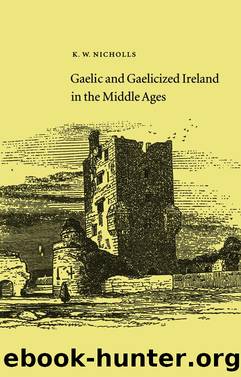Gaelic and Gaelicized Ireland by K.W. Nicholls

Author:K.W. Nicholls [K.W. Nicholls]
Language: eng
Format: epub
ISBN: 9781843514244
Publisher: The Lilliput Press
Published: 2013-03-14T16:00:00+00:00
PAPAL PROVISIONS
According to the doctrine of the fully developed canon law, the right of appointment of the clergy was inherently vested in the bishop as part of his âordinaryâ Episcopal jurisdiction. In practice, the custom of lay patronage (âadvowsonâ) was too deeply entrenched in feudal Europe for the Church to suppress it, or even attempt seriously to do so. In England, where resistance to clerical claims was especially strong, the official canon law doctrines on the subject received little recognition and where the bishop made an appointment this tended to be regarded as an exercise of a right of advowson vested in himself. In Ireland no parochial system had existed, outside the towns of the Ostmen, before the invasion of 1169, and the formation of parishes was a long-drawn-out process over the following century and a quarter, the period during which the canon law was taking its final formulated shape. In consequence the pattern of patronage in Ireland tends to vary according to the date at which the parochial system took shape in that particular region. In the east the English pattern was in general prevalent, but in Munster and Connacht â where parochial formation dated from the first half of the thirteenth century â we find the curious compromise, noted in later times as peculiarly Irish, by which although the sinecure rectory was of lay patronage or vested in a monastery, the vicar who actually performed the duties was âcollatedâ (appointed) by the bishop. In Gaelic Ulster, where the parishes were of still later origin and where there were no Norman lords to claim the right of advowson â the Gaelic lords rarely did so â both rectors and vicars (for it was the custom everywhere for each parish to have both a sinecure rectory, usually held by some student or scholar, and a vicarage) were collated by the bishops.
By canon law doctrine the pope was âuniversal ordinaryâ and could override the bishops on any matter within their jurisdiction, including ecclesiastical appointments. The earlier and most notorious employment of this right was to secure rich benefices for absentee curial officials and relatives of the pope, a practice which aroused great hostility everywhere and which led in England from 1353 onwards to the passing of the various Statutes of Provisors and of Praemunire. The poverty of most Irish benefices, and the fact that much of the revenues of the bishoprics came in the form of free entertainment which combined with the chaotic condition of the country to ensure that it would be difficult, if not impossible, for an absentee to draw any sort of revenue from it, protected Ireland from this abuse. The kind of provision which we find in Gaelic and Gaelicized Ireland, and with which we are concerned here, was of a different kind, in which a suppliant would petition the pope for appointment to a benefice. This kind of appointment only began to become common towards the close of the fourteenth century, and its great surge forward dated from the pontificate of Martin V (1417-31).
Download
This site does not store any files on its server. We only index and link to content provided by other sites. Please contact the content providers to delete copyright contents if any and email us, we'll remove relevant links or contents immediately.
| Africa | Americas |
| Arctic & Antarctica | Asia |
| Australia & Oceania | Europe |
| Middle East | Russia |
| United States | World |
| Ancient Civilizations | Military |
| Historical Study & Educational Resources |
Magic and Divination in Early Islam by Emilie Savage-Smith;(1500)
Ambition and Desire: The Dangerous Life of Josephine Bonaparte by Kate Williams(1344)
Bohemians, Bootleggers, Flappers, and Swells: The Best of Early Vanity Fair by Bohemians Bootleggers Flappers & Swells- The Best of Early Vanity Fair (epub)(1343)
Papillon by Henry Charrière(1309)
Twelve Caesars by Mary Beard(1256)
Operation Vengeance: The Astonishing Aerial Ambush That Changed World War II by Dan Hampton(1134)
What Really Happened: The Death of Hitler by Robert J. Hutchinson(1128)
London in the Twentieth Century by Jerry White(1112)
Time of the Magicians by Wolfram Eilenberger(1087)
The Japanese by Christopher Harding(1086)
Twilight of the Gods by Ian W. Toll(1084)
Lenin: A Biography by Robert Service(1043)
The Devil You Know by Charles M. Blow(985)
A Social History of the Media by Peter Burke & Peter Burke(936)
Freemasons for Dummies by Hodapp Christopher;(922)
Napolean Hill Collection by Napoleon Hill(902)
Henry III by David Carpenter;(891)
The Churchill Complex by Ian Buruma(881)
The Rise and Triumph of the Modern Self by Unknown(877)
